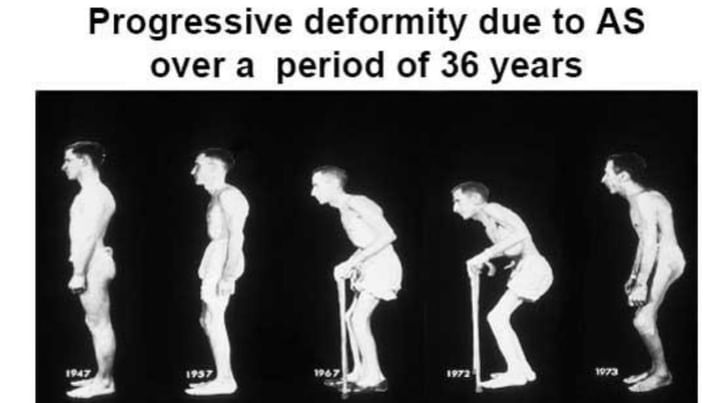Physiotherapy Management of Ankylosing Spondylitis
In the early stages of the disease a flattening of the lumbar curve may occur. Then, with increasing pain and a flexed posture, the thoracic curve can become more accentuated. If unchecked, this can be followed by a loss of cervical curve and a protracted cervical spine develops as an attempt to compensate for the forward flexion. As the hips become more flexed, hip flexion contractures can occur and the knees flex to improve balance and vision. Poor posture results in muscle fatigue, weakness, disability and a poor body image.Good management of the disease should prevent poor posture from occurring,although any fusion may be delayed and not halted. Note especially the knee flexion and hip flexion deformities. The reason for these deformities is that,if the spine is constantly flexed, the patient would fall over forwards. By flexing the knees and hips, the person shifts the line of gravity back within the base to become more stable.
AIMS OF PHYSIOTHERAPY MANAGEMENT:
The overall aims are to minimize deformity and disability and to improve well being, thereby maintaining normal function and improving the person’s quality of life.
Specifically these aims can be achieved by:
- Advising on postural awareness and ergonomics
- Reducing pain
- Maintaining and improving posture and function by a) increasing mobility of spinal, costo vertebral and peripheral joints, b) strengthening the antigravity muscles, and c) stretching specific muscle groups
- Improving and maintaining cardiovascular fitness
- Monitoring posture, mobility and function through regular assessment
- Devising and monitoring a home program of specific exercises that are suitable and consistent with long-term compliance
- Imparting knowledge about the disease and its management Improving the person’s psychological state, coping strategies and exercise compliance.
PAIN IN ANKYLOSING SPONDYLITIS
Pain may vary from low grade discomfort to intense pain.
Typically, pain is aggravated and is often reduced by exercise. The perception of pain can be influenced by several factors, including fatigue.
Physiotherapy modalities such as ultrasound, dry needling, and transcutanous nerve stimulation, mega pulse and gentle spinal mobilization can be effective, especially for localized pain.
If the person has not exercised recently, exercises will need to be commenced gradually and the person warned that initially they may provoke pain.
Wearing supportive shock-absorbing shoes can decrease the jarring effect of walking on hard surfaces and reduce the likelihood of aggravating the pain. Hot packs can reduce pain.



+1.svg)
